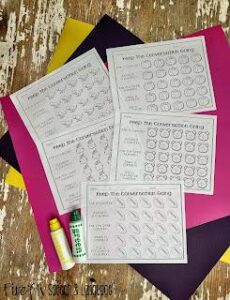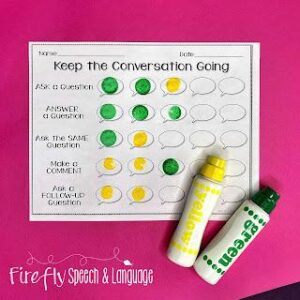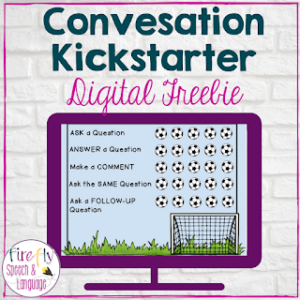When I first started working with middle schoolers, I struggled! Our social groups felt forced and heavily prompted. I needed a way to motivate, engage, and make conversation skills more concrete.
After introducing the Conversation Kickstarter I noticed my students taking more initiative. I was able to fade my verbal prompts and just quietly reinforce. Students were motivated to fill up their Kickstarters all the while maintaining interaction and building conversation skills. It was like the expectations had finally clicked!
This is the tool that helped me do that.
The Conversation Kickstarter provides
- Reinforcement
- Visual Cues
- Data
And the best part is it can be used with preschool through high school. Here is how it works:
Each student gets a copy of the Kickstarter and we review the 5 ways to keep the conversation going:
- Ask a Question
- Answer a Question
- Ask the Same Question
- Make a Comment
- Ask a Follow-up Question
For younger students, social questions like these are great for getting the conversation started, while older students may benefit from simply selecting a topic.
This tool was designed to be used with dot paint markers, however a highlighter or marker may also work. The important thing is that the mark be quick, not to take the focus off the conversation. It is best the therapist hold the marker, at least in the beginning.
Once a question is asked, the therapist places a dot on the student’s page, next to “Ask a Question.” When the question is answered, the therapist then places a dot on that student’s page next to “Answer a Question.” And off you go!
Even very young students and non-readers begin to understand the conversation expectations – “Each time I take a turn talking to a friend, I get a stamp.” Students enjoy watching their pictures fill up and are motivated to keep the conversation going.
For readers and older students, the words may be pointed to as a prompt. For example, if there is a lag in the conversation, I may point to “Make a Comment,” or “Ask a Follow-up Question” to encourage the student to keep the conversation going in one of the 5 ways. This gestural prompt is so much easier to fade than a verbal one!
Different color dot paint markers may be used for prompted vs. independent responses. You may also choose to use a different color for each topic. This is where the Kickstarter comes in handy for data collection. With one look I can see what percentage of the time my students are maintaining conversation independently or how many exchanges they are making. These simple visuals have been wonderful to share with parents at IEP meetings.
The Kickstarter is also helpful in looking at how students are keeping the conversation going. Many students are great at asking and answering questions, but often don’t reciprocate, comment, or ask follow-up questions. Having this visual reference can guide my goals, as well as providing helpful feedback for my students.
And since pragmatics can be one of the hardest things to target remotely, I even created this free digital version of the Conversation Kickstarter which can be used during teletherapy.
Now while this digital Kickstarter works a little differently, the concept is the same. Each time the student keeps the conversation going, the therapist drags a soccer ball into the goal. One Kickstarter is used for the group, and students work as a team to score.
Hope you find these tools as helpful as I have. Stay fired up!




